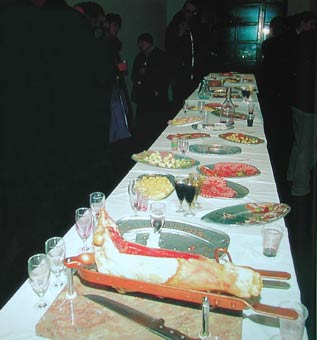Where is the line....tukaj, tukaj
Performance, Škuc Gallery, Ljubljana, 17 December 1998, duration 120 min
The performance was staged in the time of pre-New Year festivities. It took place simultaneously in two rooms of the Škuc Gallery. A large table heavily laden with food (mainly meet) and wine was set in the front room, while in distanced back room a calf was waiting in a wooden box. The visitors immediately jammed around the table and started to eat and chat. I slipped away and changed my clothes. Together with my assistant, a professional butcher, we went to the back room and killed the calf as practised in the slaughterhouse.
Some visitors noticed our departure and followed us to the back room, while others continued with the feast. Finally we put the dead animal onto a stretcher and carried it out of the gallery.
    |
Where is the Line - Here, Here...
22 December
Urša Jurman: The starting points of your performance Where is the Line - Here, Here were entirely ethical. Could you explain them?
Franc Purg: My basic starting points were eminently ethical; I aimed to open up questions about the dark sides of our existence, which are part of our everyday life, as we all know, but which we do not want to see, since they evoke extremely unpleasant feelings of guilt, disgust and dread. It is interesting, however, that all negative criticism - of which thare was a good deal - has blamed me for being unethical.
UJ: As an illustration of the dark side of our existence, which we do not want to see, you performed the sacrifice of a calf, which gave your project certain connotations. I understood the performance as a desperate appeal for animal rights and, in this context, as an explicit "zoophilic statement" similar to different movements for animal liberation, or the protection of animal rights. Do you sympathise with these movements?
FP: I sympathise with movements for animal protection, unofficially. But it was by a hair's breadth that I escaped a lawsuit from the Society Against Animal Torture; they withdrew their charge after they found out that I don't eat meat. But I don't believe that this is an important detail in this case and therefore I didn't publicise it. The action could have been done in some other way, too; I could have brought lunatics, or prisoners, or old men into the gallery, for example. It is a brittle line that divides us from "dirty" institutions, including slaughterhouses, which are all placed on the outskirts of towns so that we do not see them.
UJ: Why didn't you perform the sacrifice yourself?
FP: Sacrifice sounds much too hymnal and scriptural; this was simply slaughter. It is true that I was uncertain until that day whether I would do the killing myself or let my assistant do it. I finally decided that he should do it, for he is skilled in it and does it according to legitimate rules, quickly and effectively. And this was the most important thing for the calf, wasn't it?
UJ: Do you think the project was successful - especially given the fact that most of the critics were negative and appalled, and that they most frequently reproached you for being unethical, which is contrary to your starting points and the intention of the performance. Why did you not react to such criticism?
FP: According to the existing criteria of the Ljubljana art scene, the project was probably unsuccessful, but I didn't pay any attention to that. More interesting were the reactions of those who did not burden themselves with the question of whether the action was a work of art or not. The project simply made them think. I have never discussed any of my projects so much with people. Does this mean success? The action also had its "day after": the famous Slovene critic M. K. almost wanted to hit me at the "mortadella party" in the Museum of Modern Art. She was very emotional, but she didn't even see or feel the action in the Škuc Gallery, of course. There were similar reactions in readers' letters, editorials and columns in newspapers and magazines (e.g. Mag). I also got numerous letters by the e-mail. I had a prolonged correspondence with some of the most interesting writers; I even succeeded in convincing Lea Eva Muller. I was invited to participate in the Tednik (Weekly) programme on TV Slovenia, but I had the feeling that they wanted to speak about vegetarianism, which certainly did not interest me.
UJ: Would you agree that animals - as helpless beings whose rights have to be protected - often arouse more compassion in people than persons whose rights are violated and who are left at the mercy of others (e.g. refugees), and that people are often more horrified, concerned and engaged in cases of the torture of animals than in cases of violations of human rights?
FP: I agree, and this is also one of the questions posed by my project.
UJ: What is your comment on the contradiction in art projects that imitate, or repeat, certain acts which the artist finds problematic, with the intention of pointing at, exposing and questioning them, while the strategy, or manner, of doing it - imitation, repetition - also reproduces these acts: in your case this is the slaughter. Do you think that another - artistic - context is a sufficient "alibi" to "excuse" the imitation and, at the same time, to surpass the reproduction and thus the intensification of these problematic issues
FP: Contradiction? Alibi? Thus begins moralisation. The calf was meant
to become veal, even without my action. I simply wanted people to take
the action seriously, which could never have been achieved with a "symbolic
act", which is a trade mark of bourgeois, petty-bourgeois, art. I
was simply speaking of hypocrisy
